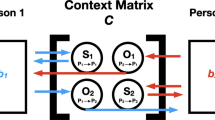Abstract
In two recent articles, McDowall (1978a, 1978b) has challenged the micro-analytic work of W. S. Condon and Adam Kendon. Specifically, he has argued on the basis of his work that “interactional synchrony” is not a genuine phenomenon, but rather a statistically expectable “noise” in social interaction. In this paper, we demonstrate that McDowall's results are inconclusive because of confusion as to what constitutes interactional synchrony. We clarify these issues and place McDowall's experiments in their proper perspective.
Similar content being viewed by others
References
Bateson, G. Metalogue: why do Frenchmen? In M. van Tuyl (Ed.)Impulse, annual of contemporary dance. San Francisco: Impulse Productions, 1951.
Bateson, G.Steps to an ecology of mind. New York: Ballantine Books, 1972.
Bateson, G. and Mead, M.Balinese character: A photographic analysis. Special Publications of the New York Academy of Sciences, vol. 2. New York: New York Academy of Sciences, 1942.
Birdwhistell, R.L. Body motion research and interviewing.Human Organization 1952,11 37–38.
Birdwhistell, R.L. Body motion. In N.A. McQuown (Ed.)The natural history of an interview. New York: Grune and Stratton, 1965.
Birdwhistell, R.L.Kinesics and context: essays on body motion communication. Philadelphia: University of Pennsylvania Press, 1970.
Condon, W.S. Method of micro-analysis of sound films of behavior.Behavior Research Methods and Instrumentation 1970,2 51–54.
Condon, W.S. Multiple response to sound in dysfunctional children.Journal of Autism and Childhood Schizophrenia 1975,5 37–56.
Condon, W.S. A primary phase in the organization of infant responding behavior. In H.R. Schaffer (Ed.)Studies in mother-infant interaction. New York: Academic Press, 1977.
Condon, W.S. Neonatal entrainment and enculturation. In M. Bullowa (Ed.)Before speech: The beginning of interpersonal communication. New York: Cambridge University Press, 1979.
Condon, W.S. and Brosin, H.W. Micro linguistic-kinesic events in schizophrenic behavior. In D.V.S. Sankar (Ed.)Schizophrenia: current concepts and research. Hicksville, N.Y.: PJD Publications, 1969.
Condon, W.S. and Ogston, W.D. Sound film analysis of normal and pathological behavior patterns.Journal of Nervous and Mental Disease 1966,143 338–347.
Condon, W.S. and Ogston, W.D. A segmentation of behavior.Journal of Psychiatric Research 1967a,5 221–235.
Condon, W.S. and Ogston, W.D. A method of studying animal behavior.Journal of Auditory Research 1967b,7 359–365.
Condon, W.S. and Ogston, W.D. Speech and body motion synchrony of speaker-hearer. In D.L. Horton and J.J. Jenkins (Eds.)Perception of language. Columbus, Ohio: Charles E. Merrill Press, 1971.
Condon, W.S. and Sander, L.W. Neonate movement is synchronized with adult speech: interactional participation and language acquisition.Science 1974a,183 99–101.
Condon, W.S. and Sander, L.W. Synchrony demonstrated between movements of the neonate and adult speech.Child Development 1974b,45 456–462.
Kendon, A. Movement coordination in social interaction: Some examples described.Acta Psychologica 1970,32 101–125.
Kendon, A. The role of visible behavior in the organization of social interaction. In M. von Cranach and I. Vine (Eds.)Social communication and movement: Studies of interaction and expression in man and chimpanzees. New York: Academic Press, 1973.
Martin, J.G. Rhythmic (hierarchical) versus serial structure in speech and other behavior.Psychological Review 1972,79 487–509.
McDowall, J.J. Microanalysis of filmed movement: The reliability of boundary detection by observers.Environmental Psychology and Nonverbal Behavior 1978a,3 77–88.
McDowall, J.J. Interactional synchrony: A reappraisal.Journal of Personality and Social Psychology 1978b,36 963–975.
Neisser, U.Cognitive psychology. New York: Appleton-Century-Crofts, 1967.
Pike, K.L.Language in relation to a unified theory of the structure of human behavior (3 vols.). Glendale, Calif.: Summer Institute of Linguistics, 1954.
Rosenfeld, H.M. Whither interactional synchrony? In K. Bloom (Ed.)Prospective issues in infant research. Hillsdale, N.J.: Erlbaum and Associates, 1981.
Scheflen, A.A psychotherapy of schizophrenia: A study of direct analysis. Springfield, Ill.: Thomas, 1960.
Scheflen, A. Communication and regulation in psychotherapy.Psychiatry 1963,28 126–136.
Scheflen, A.Stream and structure of communicational behavior. Philadelphia: Common-wealth Mental Health Research Foundation, 1965.
Author information
Authors and Affiliations
Rights and permissions
About this article
Cite this article
Gatewood, J.B., Rosenwein, R. Interactional synchrony: Genuine or spurious? A critique of recent research. J Nonverbal Behav 6, 12–29 (1981). https://doi.org/10.1007/BF00987933
Issue Date:
DOI: https://doi.org/10.1007/BF00987933




